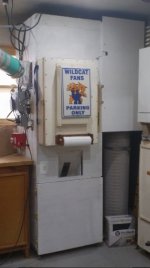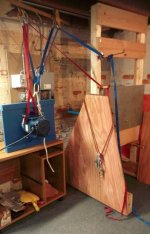Good morning:
I used the wrong word when I said I needed to find a forum and asked for recommendations. I meant another topic. I did not want to get off-topic with wiring discussion. When I first started this topic I figured that each shop is unique and a new topic would not be questioned.
I had started yesterday and the day before to scan the topics on wiring on this site (I am going to have to adjust a little because to me they are ‘forums’ on this site but I know that is not how they are reckoned by everyone else.). That is what I was asking a recommendation for… a topic best suited to what I am preparing to do that is current and still relevant. I’m also uncomfortable posting a question in a topic whose last reply was in 2005. I’m comfortable wiring a 30 amp circuit needed for this, but as I read the posts on this site (in that topic), people were talking about ‘phase’ and shutoff boxes, etc., and I realized I was out of my depth for the moment. I know how to learn and I’m not brash or impulsive. I just wanted to know how to direct my blows effectively when it comes to reading. This site is obviously the place to be because it deals with the device with which I will be working. There is just a LOT of stuff on this site and my information need is more immediate and will change once my wiring work is done, so I figured I’d ask if there is a best thread here.
I had another question that occurred to me yesterday about the dust bin that sits below the cyclone. Has anyone used (or considered) a modified hopper of a shop vac? I don't know if it is silly but it occurred to me yesterday that this might be an alternative for me to making one. These are somewhat inexpensive, wheeled, and air-tight (in/out would have to be blocked). My calculation is that I can use a box 20 inches high maximum, and that would be about a pencil thickness lower than my ceiling, which is 88.25 inches. The height I have is actually probably less if I figure on disconnecting it from the cyclone for emptying. Also, would lining this hopper (whatever I use) with a heavy garbage bag be possible, or is there a reason not to do that?
I don't know just yet how to send messages privately. I do most of my editing in Word so that I can catch spelling and grammar errors before posting. When I use site editors, I'm always at risk of losing a long message because of some hiccup or other. When I figure out how to send a private message, I will send a request for the information offered about the torsion box.
as always, thank you (all) for the help here.
I used the wrong word when I said I needed to find a forum and asked for recommendations. I meant another topic. I did not want to get off-topic with wiring discussion. When I first started this topic I figured that each shop is unique and a new topic would not be questioned.
I had started yesterday and the day before to scan the topics on wiring on this site (I am going to have to adjust a little because to me they are ‘forums’ on this site but I know that is not how they are reckoned by everyone else.). That is what I was asking a recommendation for… a topic best suited to what I am preparing to do that is current and still relevant. I’m also uncomfortable posting a question in a topic whose last reply was in 2005. I’m comfortable wiring a 30 amp circuit needed for this, but as I read the posts on this site (in that topic), people were talking about ‘phase’ and shutoff boxes, etc., and I realized I was out of my depth for the moment. I know how to learn and I’m not brash or impulsive. I just wanted to know how to direct my blows effectively when it comes to reading. This site is obviously the place to be because it deals with the device with which I will be working. There is just a LOT of stuff on this site and my information need is more immediate and will change once my wiring work is done, so I figured I’d ask if there is a best thread here.
I had another question that occurred to me yesterday about the dust bin that sits below the cyclone. Has anyone used (or considered) a modified hopper of a shop vac? I don't know if it is silly but it occurred to me yesterday that this might be an alternative for me to making one. These are somewhat inexpensive, wheeled, and air-tight (in/out would have to be blocked). My calculation is that I can use a box 20 inches high maximum, and that would be about a pencil thickness lower than my ceiling, which is 88.25 inches. The height I have is actually probably less if I figure on disconnecting it from the cyclone for emptying. Also, would lining this hopper (whatever I use) with a heavy garbage bag be possible, or is there a reason not to do that?
I don't know just yet how to send messages privately. I do most of my editing in Word so that I can catch spelling and grammar errors before posting. When I use site editors, I'm always at risk of losing a long message because of some hiccup or other. When I figure out how to send a private message, I will send a request for the information offered about the torsion box.
as always, thank you (all) for the help here.




